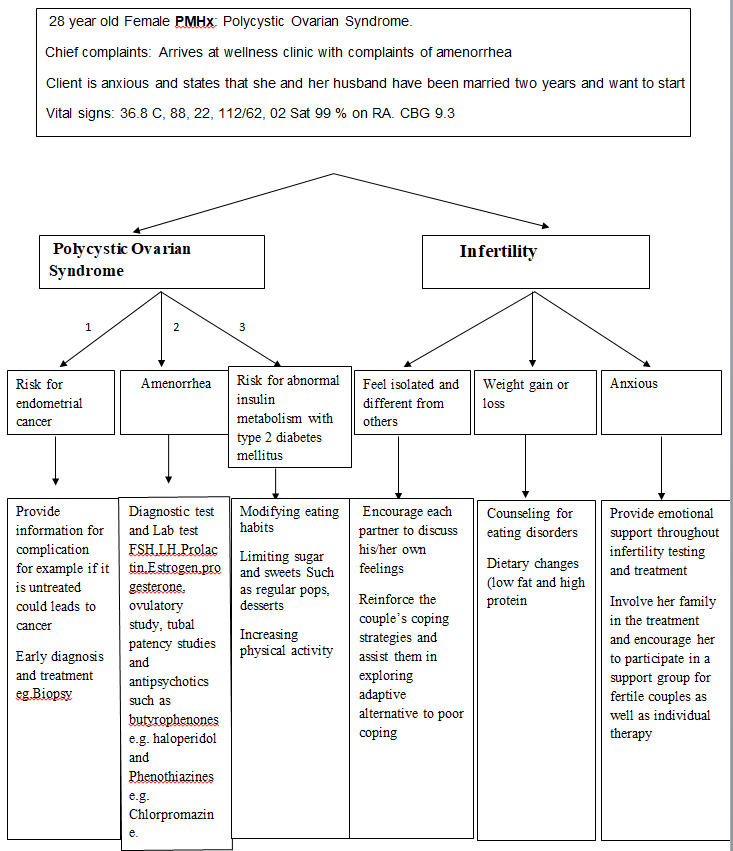
Pathophysiological justification of option 2 and 3 of Polycystic Ovarian Syndrome
Amenorrhea (Option 2)
This is defined as lack of menstrual cycle in women. Women who receive less than 9 cycles per annum have high chances of having amenorrhea. There are two forms of amenorrhea. These are primary and secondary. During early stages of a woman’s life primary amenorrhea occurs due to endocrinal imbalances. This may occur before the teenage girl reaches sixteen years. On the other hand, Secondary amenorrhea is associated with polycystic Ovarian Syndrome in older women.
It is frequently seen in women who had normal cycles before but this cycle stopped suddenly resulting in irregular cycles. The cause of these irregular cycles include, stress, anorexia as a result of malnourishments and frequent strenuous exercises. Polycystic Ovarian Syndrome is caused by hormonal imbalances in the body. The imbalances in this case cause the adrenal glands secreting more of androgen hormone than the common female hormones. This consequently leads to irregular cycles (Potter & Perry, 2009).
Treatment
Treatment using drugs that would raise the female hormone prolactin does help rectify the imbalance. Major drugs used are the antipsychotics. For instance, butyrophenones and phenothiazines are good examples. They act through dopamine-receptor-antagonism routes (Lewis, Heitkemper, Dirksen & O’Brien, 2010).
PCOS and Diabetes Mellitus Type 2 and Obesity (Option 3)
One of the symptoms of polycystic ovarian syndrome is insulin resistance. Occasionally insulin resistance results into elevated blood sugar. Too much blood sugar is transported to the liver where it is converted to into fats. Thereafter, the fats are deposited into body tissues resulting into obesity or increase in weight. To prevent weight gain, the patient should reduce consumption of high glycemic index foods. In addition, the patient should engage in frequent physical exercise to prevent cases of increase in weight.
Risk of Cancer
Most tumors of the ovary could contain cysts but this is not a necessity. Having a biopsy to check the presence of these cysts is not necessary. Amenorrhea and hormonal imbalance have a priority over cancer risks diagnostic steps (Lewis, Heitkemper, Dirksen & O’Brien, 2010). Therefore, this step could not be necessary hence can be skipped and the other two options can be considered.
Clinical Manifestations (Infertility)
Weight Loss and Weight gain
PCOS can result in dramatic increase in weight. The remedy for this should be a check on eating habits of the patient. The patient should be advised on good eating habits that would discourage the possibilities of having weight issues (Snyder, 2006). Cancelling and good eating habits are a good remedy for weight issues.
Worries and Sadness
Studies for PCOS have shown that cases of infertility have proven to cause emotional dysfunction in many women who have never gotten pregnant but not for those who have conceived before. Women who have never conceived before have frequently exhibited emotional effects such as fret and anxiety. To resolve these matters, it is prudent to have cancelling programmes for couples with PCOS disease (Snyder, 2006). Reinforcing good relationships for couples have can have positive effects on their health but not always. Another method of encouragement is provision of emotional support.
PCOS patients have effects of stress and depression that accompany their predicament. To alleviate these feelings, it is important to have these women go for fertility testing. This would help give them confidence of their condition once their treatment is accomplished (Snyder, 2006). During these test one, two or more family members can join to provide the support required in such distressing moments. Lastly, these patients are to involve themselves in therapies for fertile couples though this method provides the least effect.
Reference List
Lewis, S., Heitkemper, M., Dirksen, S., & O’Brien, P. (2010). Medical-Surgical Nursing in Canada: Assessment and Management of Clinical Problems. Toronto: Elsevier.
Potter, P., & Perry A. (2009). Canadian Fundamentals of Nursing (4th ed). Toronto: Elsevier.
Snyder, B.S. (2006). Psychosocial Effects: Women Diagnosed with Polycystic Ovary Syndrome. Journal of Obstetric and Gynecologic Nurses. 35(2), 385-392.